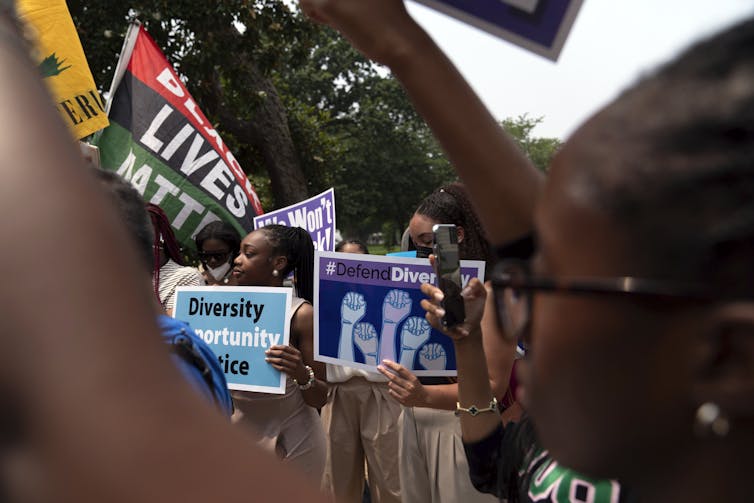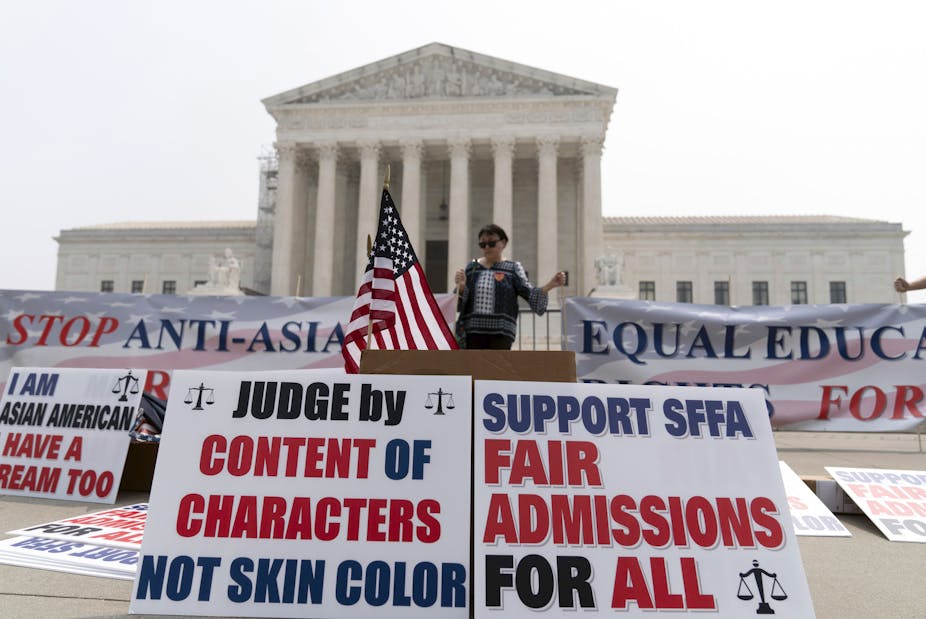In a 6-3 ruling on Thursday, June 29, 2023, the U.S. Supreme Court struck down the use of race in college admissions at Harvard and the University of North Carolina, outlawing the use of race in college admissions in general. The Conversation reached out to three legal scholars to explain what the decision means for students, colleges and universities, and ultimately the nation’s future.
Kimberly Robinson, Professor of Law at the University of Virginia
Writing for the majority in a case that bans affirmative action in college admissions, Chief Justice John Roberts wrote that such programs “unavoidably employ race in a negative manner” that goes against the Constitution.
The research, however, shows that the ban could potentially harm many college students and ultimately the United States. The reason this can be said with certainty is because in states where affirmative action has been banned, such as California and Michigan, many selective state colleges and universities have struggled to maintain the student body diversity that existed before affirmative action was banned.
Robust research shows how students who engage with students from different racial backgrounds experience educational benefits, such as cognitive growth and development and creating new ideas. For those reasons, a substantial decline in enrollment for underrepresented minority students carries many repercussions.
It means, for instance, that many students at selective colleges will have far fewer opportunities to learn from and interact with students from different racial backgrounds.
The nation’s elite colleges, such as Harvard and the University of North Carolina, educate a disproportionately high share of America’s leaders. Those who don’t attend these selective schools are dramatically less likely to complete a graduate or professional program. This is because these selective schools carry certain advantages. For instance, students who attend them are statistically more likely to graduate and be admitted to professional and graduate programs.
That means for students from underrepresented groups who don’t get into selective colleges, the chances of getting an advanced degree – which often paves the way to leadership positions – will be even lower.
The decision may also affect the workplace. Research shows that in states that eliminated affirmative action, meaningful drops in workplace diversity took place. Asian and African American women and Hispanic men experienced the most significant declines.
These shifts in elite college enrollment, leadership and workplaces will weaken long-standing efforts to dismantle the nation’s segregationist past and the privilege that this segregationist past affords to wealth and whiteness.
To help mitigate these potential harms, selective colleges will have to devote their attention to limiting what I believe are the decision’s harmful impacts and reaffirming their commitment to diverse student bodies through all lawful means.
Kristine Bowman, Professor of Law and Education Policy, Michigan State University

In striking down race-conscious admissions practices, the Supreme Court overturns the court’s 1978 decision that held that race-conscious admissions were constitutional.
This reversal was not unexpected, but it will have profound implications for building and maintaining diverse and inclusive colleges and universities, particularly among selective institutions. The most effective way to enroll a diverse student body – and achieve the educational and social benefits that come with it – is to consider race as a factor in admissions. In the 10 states that have had affirmative action bans in admissions, diversity in selective institutions has declined. This remained true even as alternative strategies were employed to achieve racial diversity, such as targeting recruitment efforts and focusing more on socioeconomic status diversity.
Although the court does not say outright that institutions cannot pursue diversity, it is not clear what diversity-related goals, if any, could constitutionally support race-conscious admissions. The court states that the benefits of diversity that Harvard and UNC articulate are not sufficiently “measurable,” “focused,” “concrete” or “coherent.” “How many fewer leaders Harvard would create without racial preferences, or how much poorer the education at Harvard would be, are inquiries no court could resolve,” the court wrote.
And yet, as Justice Sotomayor’s dissent highlights, the majority also says that race-conscious admissions with a “focus on numbers” or particular “numerical commitments” are also unconstitutional.
The opinion did not go as far as it could have in restricting the consideration of race. Institutions can still consider what a student’s comments about their racialized experiences reveal about their characteristics, such as “courage,” “determination” or “leadership.”
This provides a way for institutions to consider how race has impacted a student’s life. Although this unfairly places the burden on students of color to write about their racialized experience, it is arguably lighter than the burden that would have been borne if the court had attempted to prohibit consideration of such experiences.
Furthermore, efforts to pursue diversity through other means remain lawful. These alternative means include increasing attention to socioeconomic status, making campus communities more inclusive. It also involves checking whether students are passing classes and graduating at the same rate regardless of race.
Research hasn’t shown that these efforts will result in as much diversity at selective colleges as race-conscious college admissions. These efforts, however, now stand as a critical way forward to keep America’s elite colleges and universities diverse.
Vinay Harpalani, Associate Professor of Law, University of New Mexico
Although the court struck down the use of race in college admissions – as predicted by many experts and observers – the court left room for one narrow exception.
The majority opinion stated in a brief footnote that its ruling does not apply to race-conscious admissions at the nation’s military academies, such as West Point or the Naval Academy.
This issue had come up at oral arguments. When articulating the U.S. government’s position, Solicitor General Elizabeth Prelogar raised the point that the military may have compelling interests beyond those that universities have. Specifically, the U.S. government argued that a racially diverse military officer corps was necessary for national security. In response, Chief Justice Roberts briefly noted the possibility of a military academy exception. This was not lost in his ruling.
The majority opinion stated that there could be “potentially distinct interests that the military academies may present.” Because the academies were not parties to these cases, the court did not directly address this issue and left it unsettled.
This was not the first time that the military influenced the court’s view of race-conscious admissions. Twenty years ago, national security interests played a significant role in the majority opinion in Grutter v. Bollinger.
Citing the amicus brief of former military leaders, Justice Sandra Day O’Connor’s majority opinion in the Grutter case noted that diverse military leadership was “essential to the military’s ability to fulfill its principle mission to provide national security.” She found that “[i]t requires only a small step from this analysis to conclude that our country’s other most selective institutions must remain both diverse and selective.”
In its latest rulings, the court left alone O'Connor’s claim that diverse military leadership is essential to national security, but it soundly rejected her view that diversity can justify race-conscious admissions at the nation’s colleges and universities.
The military is not the only place where the court has noted that security interests can justify use of race. The court also cited a 2005 ruling, Johnson v. California, where the justices held that prison officials could temporarily segregate prisoners by race to prevent violence.
It seems that the court is willing to uphold use of race when government power is at stake – as with the military and law enforcement. But it will not do so for the education of America’s citizenry.

